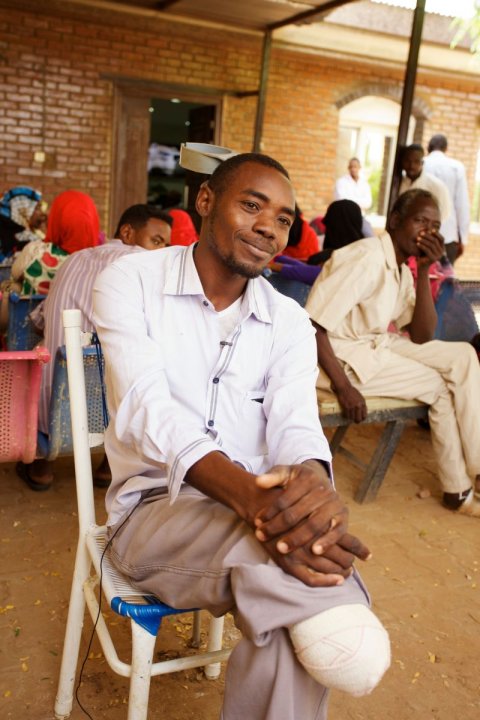A new treatment for mycetoma?
How do you treat a disease where the number of people affected is not known, diagnosis and prevention are very difficult, and the cause remains unclear? It devastates people’s lives, often leaving them limbs amputated and other permanent, life-changing disabilities, often unable to earn a living and trapped in a cycle of poverty. This is the question DNDi are aiming to tackle with the first-ever clinical study for a potential new mycetoma drug.
What is mycetoma?
Mycetoma is a slow-growing bacterial or fungal infection, most often starting with the foot. It attacks skin, deep muscle and bone, and is believed to enter the body via thorn pricks or lesions on the feet, although there have been no studies carried out to confirm this theory. Without information on the cause, prevention becomes extremely difficult. It affects mostly poor people in rural areas – in particular, young males aged between 15 and 30.
Due to the lack of effectiveness of available treatment, most lesions do not heal and instead recur on other parts of the body, leading to amputation and sometimes repeated amputations. The psychological impact of mycetoma is also severe: many patients become depressed and need psychological support.
The ‘mycetoma belt’, the area of the world in which the disease is mostly found, includes Chad, Ethiopia, Mauritania, Senegal, Somalia, and Sudan, as well as India, Mexico, Venezuela, and Yemen. However, there is no global surveillance and therefore limited epidemiological data.
Despite the impact of mycetoma, there has been little or no funding or research attention to the disease until very recently. In 2016, WHO added mycetoma to the list of the 18 neglected tropical diseases, which somewhat increased the likelihood of better monitoring and research funding, although mycetoma remains among the most neglected of neglected diseases.

I got mycetoma 19 years ago after I was pricked by a thorn. Even after numerous treatments, eight surgeries, and finally an amputation of my leg, I don’t think I am healed. I dropped out of school after my first surgery and I had to stop working after the amputation. This disease has been difficult on me, my wife, and five children.” Alsadik Mohamed Musa Omer, Sudan
Diagnosis
The lack of accurate data on mycetoma incidence and prevalence means that the governments of affected countries do not prioritise the improvement of diagnosis, treatment and care.
There are no point-of-care diagnostic tests for use in mycetoma-endemic villages. Most available mycetoma diagnostic tests and techniques are invasive, expensive, lengthy, of low specificity and sensitivity, and not available in endemic regions. People must travel long distances to provincial hospitals to access them.
Treatment is ineffective
New treatments for fungal mycetoma are urgently needed as there are fundamental limitations of existing medicines.
The treatment depends on the type of mycetoma. For the bacterial type (actinomycetoma), combination antibiotics are used, with up to 90% cure rates. For the fungal type (eumycetoma), a combination of antifungal drugs and surgery is used. Available eumycetoma treatment is frustratingly ineffective, even after 12 months of treatment, and very expensive, with many side effects.
Repeated courses may be necessary – often to no avail. Ketoconazole has side effects, and concern over its liver toxicity has caused the US Food and Drug Administration (FDA) and the European Medicines Agency (EMA) to restrict its use.
One of the few studies on mycetoma, conducted at the MRC in Khartoum, Sudan, showed that of the 1,242 eumycetoma patients studied: 54% or 671 patients dropped out from outpatient follow-up for various reasons, including treatment side effects and dissatisfaction with the therapy outcome.
Antifungal drugs are also simply not often available in endemic areas. If they are available, they are commonly unaffordable. In Sudan, for example, most patients pay for their treatments out of pocket. The cost of itraconazole treatment is equivalent to an average monthly salary.
First-ever clinical study for potential new mycetoma drug
In 2015, DNDi added mycetoma to its Research & Development portfolio. Two years later with the Mycetoma Research Centre in Sudan and the Japanese pharmaceutical company Eisai, they launched a clinical trial for a promising new antifungal treatment, fosravuconazole, in the first-ever double-blind randomised clinical study for mycetoma.
Fosravuconazole has shown strong antifungal activity against mycetoma in the laboratory and has the potential to be an affordable, oral drug.
Dr Ahmed Fahal, Professor of Surgery, University of Khartoum and Director, MRC, said: “With patients now enrolled in the study, what we have been working towards for the last 28 years is at last becoming a reality. An effective, safe, affordable, and shorter-term curative treatment which is appropriate for rural settings is desperately needed for neglected patients suffering from mycetoma.”
And even more recently, in 2018, the University of Sydney, Erasmus MC, and DNDi launched the Mycetoma Open Source project (MycetOS), which uses an Open Pharma approach to discover new drug candidates (new chemical entities, or NCEs) for eumycetoma using open-access data and collaborative methods. You can participate by @MycetOS on Twitter.
Need for continued advocacy
While drug trials are underway, there is a need in the meantime to think more creatively about treatments and ensure that we have adequate reporting.
As a Society, we called for abstracts on mycetoma for the European Congress on Tropical Medicine and International Health (ECTMIH 2019), which we’re hosting this September in Liverpool, as well as for our small grants programme. Join us at ECTMIH 2019, for two abstract sessions and an organised session specifically on mycetoma. The event programme is now online.
We are also working with the mycetoma community to identify what else we could do to address this devastating disease.
Sign up to our newsletter for more updates